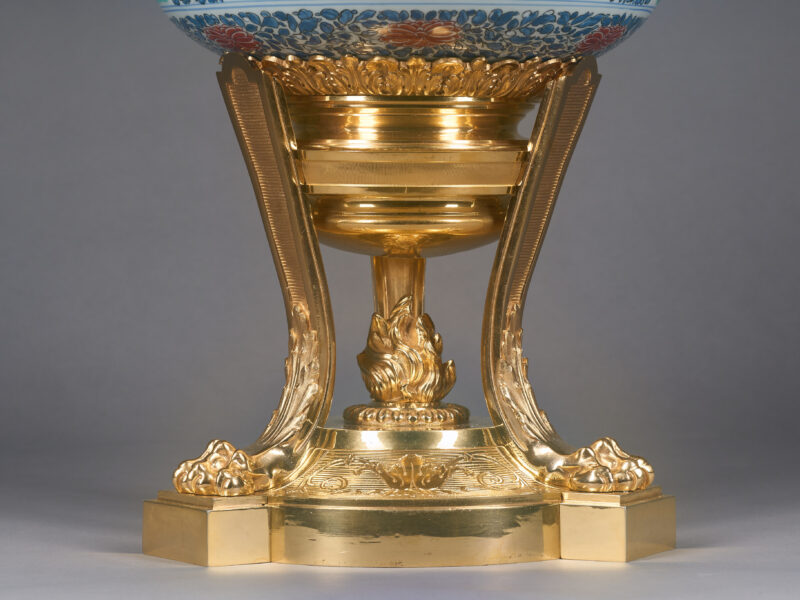
Magnificent Potpourri Centerpiece
Gilded ornate stand in a round shape with three prominent pedestals, each adorned with lion’s paws, acanthus leaves, and ornamental motifs. The center of the base is designed in the form of a large flame.
The three feet, enclosing a gilded bowl, are crowned with an acanthus leaf frame and transition into the Imari-style potpourri bowl.
Above the large porcelain bowl, there is an intricately pierced gallery decorated with laurel leaf garlands, upon which sits the lid, crafted with a knob in the shape of three large acanthus leaves and crowned with a large pineapple.
The porcelain bowl and the final lid are executed in the Kakiemon style, known for delicate imagery and a subtle color palette ranging from shades of orange, yellow, blue to turquoise.
The fine painting depicts a landscape scene with Japanese figures carrying umbrellas and fans, and Japanese cherry blossom trees, also known as Sakura trees. The imagery is surrounded by delicately painted leaf and flower garlands.
Large potpourri centerpieces like this were made in the 18th and 19th centuries for noble houses. They were filled with fragrant flowers and oils, which would release their pleasant scent even when the piece was closed, thanks to the pierced gallery.
About the Porcelain:
The name “Imari porcelain” originates from the small port of Imari near Arita, from where the goods were transported to the Dutch East India Company’s settlement in Nagasaki. Both Arita and Imari are located in the present-day Saga Prefecture in the northern part of Kyushu Island.
The name “Kakiemon porcelain” derives from the Sakaida Kakiemon family business near the city of Arita in the Hizen province. Kakiemon was the first in Japan to develop a polychrome style for porcelain painting around 1643, using imported pigments from China that could be fired onto the initial glaze.
He introduced a painting style influenced by Chinese porcelain from the time of Emperor Kangxi, featuring sketch-like lines, watercolor-like application of colors, and asymmetrical compositions leaving large areas unpainted. Kakiemon porcelain is a subcategory of Arita porcelain and belongs to the group of Imari porcelains.
The Kakiemon style developed by Sakaida Kakiemon in the early 17th century is still cherished by his descendants to this day. It is characterized by an exceptionally delicate color palette (persimmon orange, yellow, blue, turquoise, etc.) and ornamental patterns applied on a white background.
The discovery of this porcelain for Europe is credited to Zacharias Wagner, a Dresden merchant who served as the chief merchant of the Dutch East India Company and took charge of the Dejima settlement in Nagasaki for a year in 1656. The first major order for Europe was placed in 1659, and from 1757 onwards, these porcelain pieces were exported to Europe in large quantities.
European porcelain manufacturers started incorporating Imari-style porcelains, especially from the mid-18th century, following a boom in the 19th century for Asian porcelains.
Literature on Imari Porcelain:
Peter Pantzer: Imari-Porzellan am Hofe der Kaiserin Maria Theresia. Hetjens-Museum-Deutsches Keramikmuseum, Düsseldorf 2000.
Georges Le Gars: Imari, Histoire d’un style, faïences et porcelaines du Japon, de Chine et d’Europe. Massin, Paris 2004.
Georges Le Gars: Les Imari anglais. Massin, Paris 2007.
S. Noma (Ed.): Arita ware. In: Japan. An Illustrated Encyclopedia. Kodansha, 1993, p. 53.
Masako Shono: Japanisches Aritaporzellan im sogenannten „Kakiemonstil“ als Vorbild für die Meißener Porzellanmanufaktur. Schneider, München 1973 (dissertation, University of Bonn 1971).



